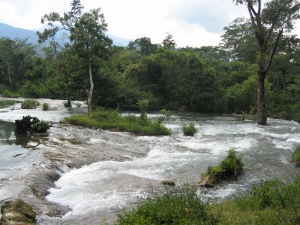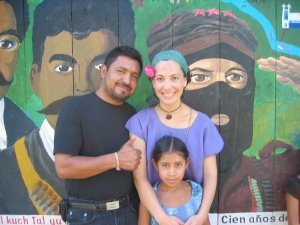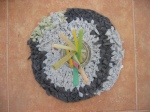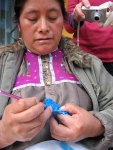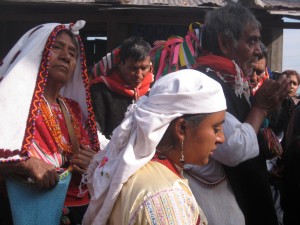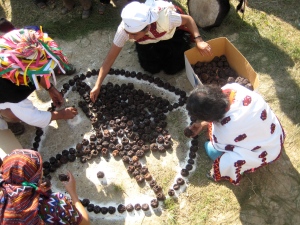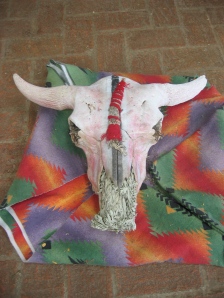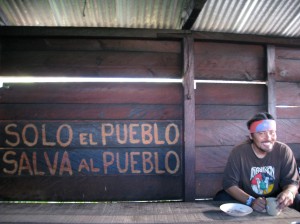 From my friend Zeynep’s villa on the peninsula near the Turkish seaside vilIage of Kaş, you can see a row of island rocks that together look like the visible top of a giant undulating underwater serpent. At the time of my visit, I was reading about the conquest of Mexico[1] and so this vision made me think of Quetzalcoatl, that legendary feathered-serpent god who, some claim it was prophecied, would one day return in the form of a white man with flaming hair and beard. This would have disastruous consequences for the indigenous population, as the flaming bearded man turned out to be the Spanish conquistador Hernán Cortez who brought with him the most brutal destruction of Mesoamerican indigenous peoples and their way of life.
From my friend Zeynep’s villa on the peninsula near the Turkish seaside vilIage of Kaş, you can see a row of island rocks that together look like the visible top of a giant undulating underwater serpent. At the time of my visit, I was reading about the conquest of Mexico[1] and so this vision made me think of Quetzalcoatl, that legendary feathered-serpent god who, some claim it was prophecied, would one day return in the form of a white man with flaming hair and beard. This would have disastruous consequences for the indigenous population, as the flaming bearded man turned out to be the Spanish conquistador Hernán Cortez who brought with him the most brutal destruction of Mesoamerican indigenous peoples and their way of life.
Ruminating on this most disastrous case of mistaken-identity as I gazed out across the sapphire waters to this Mediterranean Quetzalcoatl, I wondered at what is visible and submerged in contemporary Turkey and its history. Was the half-sunken serpent a fitting metaphor for the seen and unseen of “The Deep State,” a concept introduced to me by Zeynep in our discussions on Turkish Nationalism? Or was Mustafa Kemal “Atatürk”, the omnipresent Father of Modern Turkey, in some way the local Quetzalcoatl equivalent of his time, as a heralder of a Modernity which would later serve to harbor the influxes and proliferation of Neoliberalism and Globalization? I am deeply suspicious of such paternalistic nation-building figures, especially as according to the mythic nationalist psyche of Modern Mexico, Cortez is portrayed as the nation’s “father” who raped our indigenous “mother” (Malintzin, the Mayan princess who had little choice but to translate for the invader, but who is portrayed by the nationalist and indigenist narratives as a traitor). If this is how Modern Mexico was born, then it might explain the tangle of soap opera horror-show politics that now characterizes Mexico’s elite governance, not to mention the self-hatred that such a violent union implies.
Back in Istanbul, I continued to think about the “Deep State” and its manifestations, both here and back in the places where I’ve lived. Istanbul is a city that may still hold nostalgia for its former imperial glory, but which seems to have embraced a Western Modernity heralded and championed by Atatürk with unquestioning stride and pride. Political theorists and historians will tell you that the cult of Atatürk was intentionally revived after the 1980 Military coup, first by the state, but strangely enough, now enthusiastically enforced by citizens themselves. Thus, it is not that a mandatory law decrees Atatürk’s likeness be exhibited in every public and private place of business, but rather a sense of obligation and political posture that is set forth mainly by middle and upper-class champions of Modernity. Posters (or puzzles–as in the room we held yoga in of Istanbul University, or carpets—as in the likeness at my local coiffeur’s, or bronze statues–as in the streets and parks) of the modern nation’s father, adorn every school, business and office, including that of my sister’s mother-in-law at the women’s health clinic, and even the stage of my nephew’s pre-school performance that I attended upon landing from Beirut.
In our day and age of Post-Everything, the very concept of the nation/state seems obsolete, and so it seems foolish to keep perpetuating identities such as “Turkish” or “Mexican”, or even more absurdly the incredibly misleading “American.” Zeynep and I took care in calling each other on these slips when we spoke about my cooking up some “Mexican” food, or drinking some “Turkish” rakı. In the Zapatismo of Chiapas, where I live, such Identity Politics seem to have actually evolved some, arriving at an understanding that encompasses our diverse mythological histories (as much of the Mesoamerican and Colonial, as those of Modern Nationalism), yet remains acutely aware of the construction process itself and the importance of constant self-reflection (Caminando Preguntado). The larger social identity of Zapatismo includes all of us (Todos Somos… and Detras de Nosotros Estamos Ustedes). Theirs/Ours is a reclaimed modernity on local terms that is comfortable with past and present contradictions, always championing the diversity of the collective. Caminando Preguntando, is the methodology for remaining ever in-process of forging this contemporary collective “re-existence,” a concept introduced at the end of my friend Jeff Conant’s latest book, A Poetics of Resistance.
Such sights, memories, and metaphorical imaginings have brought me to reflect on some ways in which national and cultural myths have constructed collective histories and identities in both Mexico’s and Turkey’s present-day modernities. In both dominant national narratives, what is seen and unseen, but felt… and by whom, reflects a critical thinking and imagination (or lack of) that is badly needed to deal with our current era of globalization and its discontents. Examining what explicit and hidden assumptions guide our past and future endeavors is crucial if we are to have any chance of effecting some change in our places…or at least to keep from repeating a case of mistaken identity.
[1] in John Ross’ history of Mexico City, El Monstruo, which I highly recommend.

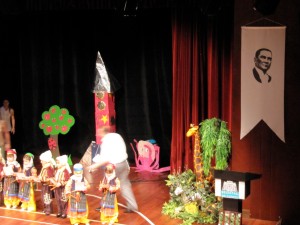
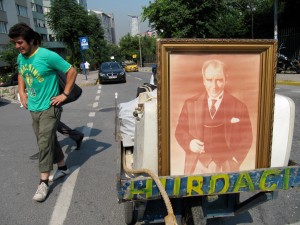
 En 1992, mientras se celebraban los cinco siglos de algo así como la salvación de las Américas, un sacerdote católico llegó a una comunidad metida’en las hondonadas del sureste mexicano. Antes de la misa, fue la confesión. En lengua tojolobal, los indios contaron sus pecados. Carlos Lenkersdorf hizo lo que pudo traduciendo las confesiones, una tras otra, aunque él bien sabía que es imposible traducir esos misterios: –Dice que ha abandonado al maíz –tradujo Carlos–. Dice que muy triste está la milpa. Muchos días sin ir. –Dice que ha maltratado al fuego. Ha aporreado la lumbre, porque no ardía bien. –Dice que ha profanado el sendero, que lo anduvo macheteando sin razón. –Dice que ha lastimado al buey. –Dice que ha volteado un árbol y no le ha dicho por qué. El sacerdote no supo qué hacer con esos pecados, que no figuran en el catálogo de Moisés.
En 1992, mientras se celebraban los cinco siglos de algo así como la salvación de las Américas, un sacerdote católico llegó a una comunidad metida’en las hondonadas del sureste mexicano. Antes de la misa, fue la confesión. En lengua tojolobal, los indios contaron sus pecados. Carlos Lenkersdorf hizo lo que pudo traduciendo las confesiones, una tras otra, aunque él bien sabía que es imposible traducir esos misterios: –Dice que ha abandonado al maíz –tradujo Carlos–. Dice que muy triste está la milpa. Muchos días sin ir. –Dice que ha maltratado al fuego. Ha aporreado la lumbre, porque no ardía bien. –Dice que ha profanado el sendero, que lo anduvo macheteando sin razón. –Dice que ha lastimado al buey. –Dice que ha volteado un árbol y no le ha dicho por qué. El sacerdote no supo qué hacer con esos pecados, que no figuran en el catálogo de Moisés.
